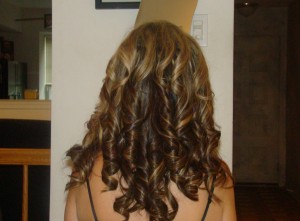Wig Care 101: Brushing and Styling Your Wig
Just like your natural hair, wigs need daily brushing and styling to stay well-maintained and looking their best. No doubt you’re an expert at fixing your own hair. But styling a wig is slightly different because of two key disparities: each strand of hair is tied – not deeply rooted into – the wig’s “scalp,” and these hairs do not regenerate themselves with new growth. Taken together, these differences warrant some special care to make sure your wig has a long and healthy life.
Wig Brushing Tips
- Never comb or brush wet synthetic hair. This can ruin the fibers and loosen the knots holding the fibers to the wig base, thus shortening the lifespan of your hairpiece.
- You may comb a wet human hair wig, but do so carefully, following the tips and methods described below.
- Always brush or comb your wig (natural or synthetic) using a downward motion, starting from the bottom and working your way up in 1- to 1.5-inch wide sections. This will reduce the strain on the knots, and reduce breakage
- Always use a wig brush, comb, or pick with plastic or metal teeth – never a horsehair or soft fiber brush, which can permanently frizz, tangle, or weaken the knots on your hairpiece.
- Always place your wig on a stand before brushing or combing. This helps the hairpiece retain its shape, keeps the fibers flowing downward the way they were designed to fall, and makes the hairpiece easier to manage while you are styling it.
- For wigs with tight curls and ringlets, use your fingers and pick to separate and define the curls instead of a comb.
Wig Styling Tips

Synthetic Wigs:
- Know your wig! Conventional synthetic wigs neither need to be styled nor easily accept styling beyond combing out the fibers and maintain its original shape. Do not use heated implements on this kind of hair (e.g. curling irons, blow driers, straighteners, etc.) as these will melt the fibers, causing permanent damage.
- Heat-friendly wigs require no styling, but can accept curling or straightening using heated implements at low temperatures. However, be aware that such restyling is permanent until the next time you restyle your hair.
- Always wait until your hair is dry to style it.
- Place your hair on a wig stand to style it. This is much easier than trying to style it on your own head and is safer for the wig.
- Do not attempt to re-color your wig – the synthetic fibers are color-fast (meaning they will not fade over time), and will not accept additional color treatments. If you would like a change, consider purchasing the same style wig in a different color.
Human Hair Wigs:
- Experiment! One of the benefits of a human-hair wig is the flexibility you have to style and re-style it, just like your own hair. Wear it up or down, straight or curly, parted in the middle or to one side. If you have a lace front or mono top wig, your scalp and hairline will appear natural, so feel free to wear your hair in whatever style you like. Machine-made wigs offer slightly less flexibility, but you may still style your hair in any way that does not alter the way in which the hair has been parted to reveal the “scalp.”
- Use heated implements with moderation. Although human-hair wigs can be styled using curling irons and straighteners, these can damage the hairpiece just as they do your natural hair if used too frequently. Always use these tools on the lowest effective setting and as infrequently as possible. If you need to curl or straighten your hair daily, consider purchasing a wig created in the style you wish to achieve.
- Choose a stylist who is familiar with working with wigs if you wish to cut hair. Remember, however, that unlike natural hair, wigs do not grow out and length changes are permanent.
- Re-color your wig with care – natural hair wigs do accept color, but such chemicals are as harsh to hairpieces as they are to natural hair and can reduce the lifespan of your wig if applied frequently.
